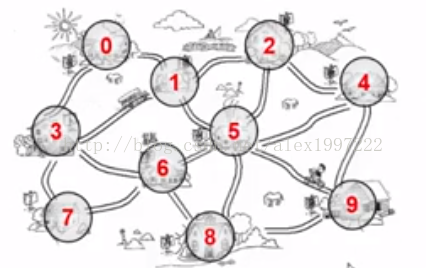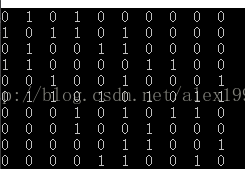图是表示“多对多的关a系”
包含:
一组顶点, 通常用V表示顶点集合
一组边:通常用E表示边的集合
边是顶点对:(v,w)表示从V指向W(无向边)
有向边<v,w> 表示从v指向w的边---> 单行线
不考虑重边和回路
图的类型:
无向图:没有方向的图
有向图:拥有方向的图,两条点之间的边带有箭头
网络图:边带权重的图
如何在程序中实现一个图?
(1)邻接矩阵->G[N][N]

实现程序如下:
#include<iostream>
#include<algorithm>
#define N 10
using namespace std;
int G[N][N];
int main() {
for (int i = 0; i < N; ++i)
for (int j = 0; j < N; ++j) {
G[i][j] = 0;
if (i == 0 && (j == 1 || j == 3))
G[i][j] = 1;
if (i == 1 && (j == 0 || j == 3 || j == 2 || j == 5))
G[i][j] = 1;
if (i == 2 && (j == 1 || j == 4 || j == 5))
G[i][j] = 1;
if (i == 3 && (j == 0 || j == 1 || j == 6 || j == 7))
G[i][j] = 1;
if (i == 4 && (j == 2 || j == 5 || j == 9))
G[i][j] = 1;
if (i == 5 && (j == 1 || j == 2 || j == 4 || j == 6 || j == 8 || j == 9))
G[i][j] = 1;
if (i == 6 && (j == 3 || j == 5 || j == 7 || j == 8))
G[i][j] = 1;
if (i == 7 && (j == 3 || j == 6))
G[i][j] = 1;
if (i == 8 && (j == 5 || j == 6 || j == 9))
G[i][j] = 1;
if (i == 9 && (j == 4 || j == 5 || j == 8))
G[i][j] = 1;
}
for (int i = 0; i < N; ++i) {
for (int j = 0; j < N; ++j) {
cout << G[i][j] << " ";
}
cout << endl;
}
system("PAUSE");
return 0;
}
观察可得: 斜对角矩阵全为0 意思是一个点到自己的距离
以斜对角为轴 该图是对称的
所以空间上有浪费
度的概念: 入度指向这条边的边的条数
出度:从一个度出发 指向别的边
邻接表的表示方法:
邻接表:G[N]为指针数组,对应矩阵每行一个列表
只存非0元素
图的建立:
邻接矩阵表示法
#include<iostream>
#include<algorithm>
#include<stdlib.h>
#define MAXSIZE 10
using namespace std;
typedef int weightType;
class eEdge {
friend class GraphicOperation;
private:
int V1; //顶点1
int V2; //顶点2
weightType weight; //一条边的权重
};
class Graphic { //图框架的定义
friend class GraphicOperation;
private:
int Nv; //顶点的个数
int Ne; //边的个数
weightType G[MAXSIZE][MAXSIZE]; //用来存放顶点关系的二维数组
};
class GraphicOperation {
private:
Graphic* ObjectGrahpic;
public:
GraphicOperation() {
ObjectGrahpic = new Graphic(); //创建对象
}
void CreateGraphic(int vertexNum); //创建一个图 初始化:只有顶点没有边
void InsertGraphic(eEdge* E); //插入一条边
void BuildGraphic(); //图的建立
};
void GraphicOperation::CreateGraphic(int vertexNum) {
ObjectGrahpic->Nv = vertexNum;
ObjectGrahpic->Ne = 0;
for (int V = 0; V < ObjectGrahpic->Nv; ++V)
for (int E = 0; E < ObjectGrahpic->Nv; ++E)
ObjectGrahpic->G[V][E] = 0; //图的初始化工作
}
void GraphicOperation::InsertGraphic(eEdge* E) { //在图中插入一条边
ObjectGrahpic->G[E->V1][E->V2] = E->weight; //无向图只需插入一条边
ObjectGrahpic->G[E->V2][E->V1] = E->weight; //有向图需插入两次
}
void GraphicOperation::BuildGraphic() {
//首先读入顶点
int vertexNum;
cin >> vertexNum;
CreateGraphic(vertexNum);
//然后读入边
int edgeNums;
cin >> edgeNums;
ObjectGrahpic->Ne = edgeNums; //边的条数
//之后创建边并插入
if (ObjectGrahpic->Ne != 0) {
eEdge* E = new eEdge();
for (int i = 0; i < ObjectGrahpic->Ne; ++i) {
cin >> E->V1 >> E->V2 >> E->weight;
InsertGraphic(E); //把边插入即可
}
}
}邻接表的使用:
首先定义顶点
class Vnode {
friend class VnodeAdjList;
private:
adjVnode* FirstEdge; //指向下一条边
dataType data; //存放的数据
};然后定义协调顶点和边的模块
class adjVnode {
friend class adjVNode; //调节节点
public:
verTex Adj; //下一个顶点的信息
weightType Weight; //边的权重
adjVnode* next; //指向下一个节点
};存储边的信息
class eEdge {
friend class GraphicOperation;
private:
int V1; //顶点1
int V2; //顶点2
weightType weight; //一条边的权重
};图的框架
//存放图的数据
class Graphic {
friend class GraphicOperation;
public:
int Nv; //顶点的个数
int Ne; //边的条数
Vnode G[MAXSIZE]; //用来存放顶点
};图的创建操作(和邻接矩阵相似)
void GraphicOperation::CreateGraphic(int VertexNum) {
verTex V, W;
objGrahpic->Nv = VertexNum; //先初始化顶点
objGrahpic->Ne = 0; //后将边初始化为0
for (int V = 0; V < objGrahpic->Nv; ++V) {
objGrahpic->G[V].FirstEdge = NULL; //把每一个顶点的初始边设置为0
}
}边的插入操作
//边的插入
void GraphicOperation::InsertEdge(eEdge* edge) {
adjVnode* newNode = new adjVnode(); //创建一个新的节点
newNode->Weight = edge->weight;
newNode->Adj = edge->V2; //指向的下一个顶点
//节点的插入
newNode->next = objGrahpic->G[edge->V1].FirstEdge;
objGrahpic->G[edge->V1].FirstEdge = newNode;
}插入操作示意图:

最后
以上就是顺心奇异果最近收集整理的关于数据结构 图的初始化的全部内容,更多相关数据结构内容请搜索靠谱客的其他文章。
本图文内容来源于网友提供,作为学习参考使用,或来自网络收集整理,版权属于原作者所有。








发表评论 取消回复